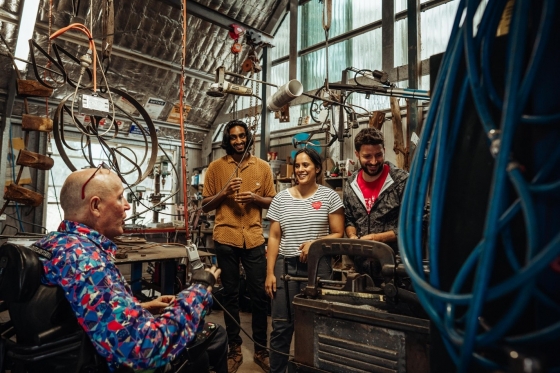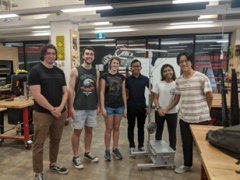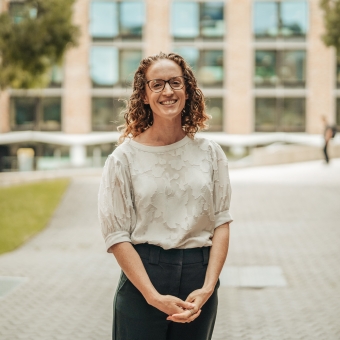By joining RehabENG, each student will get the chance to work on an impactful, hands-on assistive technology project with a tangible result, and join a community of like-minded students, academics, partners and industry professionals across the biomedical field.
Project Snapshot
About ChallENG Student Project
- At RehabENG, we look for students who are passionate about engineering design and assistive technology, and looking to enhance their degree with hands-on, collaborative project work.
- We welcome members from all faculties and disciplines as our projects require expertise across engineering, software, design and medicine.
- Apply skills and knowledge from coursework in a practical and specialised project.
- Co-design alongside partners with a disability.
- Learn how to function and collaborate as part of a multidisciplinary team.
- Work in partnership with biomedical professionals and grow your network within the health and humanitarian fields.
- Help grow the supportive RehabENG student community, taking part in events, projects and leadership roles.
In many countries, surgical lamps are not easily accessible or affordable, and power supply to hospitals can be patchy, with serious impacts to operating theatres.
To solve this problem, this project aims to design an uninterruptible power supply PCB circuit and mechanical components for a low-cost surgical lamp. Manufacturing and assembly will also be undertaken by the project team.
Work on a humanitarian project in the biomedical field, and learn skills such as circuit design, scalability and manufacturing!
Create a system to allow an athlete with cerebral palsy to grip and rotate an oar.
Our partner Jack Calderan is a talented para-athletic rower living with Cerebral Palsy. The condition affects his right hand such that proper use of the right-hand oar in sculling, which makes use of two oars, is limited by his ability to:
1. Maintain a grip on and
2. Rotate the oar.
The aim of our project is to develop a solution to these challenges and allow Jack to fulfil his dream of sculling, opening up significantly more competitive opportunities.
The project focuses on mechanical principles to stabilise the wrist and rotate the oar. The final product requires significant considerations of stress and environment to ensure a suitable lifetime and optimised performance.
Help improve the quality of life of people with quadriplegia through assistive technology.
Mouth sticks are a common tool used by people with quadriplegia to perform small tasks such as typing, pushing buttons and operating smartphone/tablet devices mounted to their wheelchair tray.
This project aims to improve current assistive technology by addressing the lack of versatility with fixed length mouth sticks whilst working with a Biomedical Engineer at the Prince of Wales Hospital.
Showcase and grow your problem-solving, mechanical design, CAD modelling, 3D-printing and prototyping abilities!
Design and build retrofittable enhancements for wheelchair users in remote and low-resource areas.
Remote and low-resource communities often only have access to cheap, off-the-shelf wheelchairs. In suboptimal conditions, these wheelchairs are prone to user discomfort, serious damage or complete failure.
This project is a collaborative competition between RehabENG UNSW and the University of Canterbury in Christchurch, aiming to design and prototype low-cost, retrofittable systems to enhance the durability and user comfort of standard wheelchairs. The two teams will meet at the end of the year to translate the designs to a final product.
The project includes a design and testing team. The final product may be distributed to remote or low-resource communities in Australia and the Pacific region.
This project is a collaboration between Rehabilitation Engineering UNSW and students from Makerere University to design and develop a prosthetic hand that is suitable for the context and environment in Uganda.
The project aims to develop an affordable and functional prosthetic hand that can improve the lives of people with upper limb amputations in Uganda.
Work in a multidisciplinary team on an ambitious and impactful project!
It is a right for children to have the ability and accessibility to play with toys. RehabENG and BESS is working towards providing equal access and opportunities for children with disabilities to play with toys. We are creating affordable and inclusive switch adapted toys for children who have limited mobility. By doing so, we empower children to independently engage with toys which will help in their growth and development of motor, cognitive, linguistic, and social interaction skills.
Our mission is to ensure that every child has an opportunity to learn, thrive and experience joy through play.
If you are interested in creating a more inclusive community by modifying toys to be more accessible to every child, reach out to our team!
Conditions apply to receive Non-Traditional Industrial training for Student Projects. You will need to apply (Student Portal Stage 2) for this Project before you commence so the days can count towards your Industrial Training (IT) program requirement (maximum 30 days). Being a member of a Student Project does not guarantee that you will receive a Non-Traditional IT placement and should not be the only motivating factor for joining a team. See Student Information for more information.
- Facebook group: https://www.facebook.com/groups/rehabengunsw
- Facebook page: https://www.facebook.com/rehabengunsw
- LinkedIn page: https://www.linkedin.com/company/rehabengunsw
- Website (under development): https://unswrehabeng.com


